Laos: Luang Prabang, its temples and waterfalls
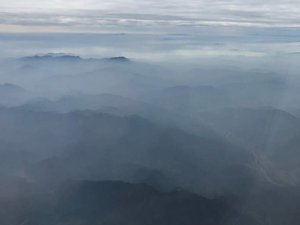
Arriving at the small Luang Prabang airport after a calm flight over the misty mountains, we were happy to discover a new country after a month spent in Vietnam.
The visa on arrival was quickly obtained and the hotel owner was waiting for us with his car. The atmosphere and driving style was radically different from Vietnam: calmer, less noise, no untimely horns. Whew! On the other hand, our hotel, booked well in advance because during the holiday season, we were very disappointed: a room in the basement without a window with floor-to-ceiling panelling! Never mind that.
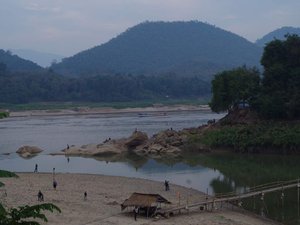
The end of storm Tembin, which had ravaged the Philippines a few days earlier, was coming to the Indochina peninsula. So the day after our arrival, we had a non-stop rainy day. We took the opportunity to go to school, watch cartoons and blog.
Luang Prabang is a beautiful, quiet and clean city. Immediately, we felt very good there (except in the room where we were suffocating a little). It is situated on the Mekong River and the old town is set between the Nam Kan River and the river. It is known for its many temples and the whole city has been listed as a UNESCO World Heritage Site. The main street and the banks of the Mekong River are lined with well-preserved colonial houses, while the golden pagodas are scattered everywhere.
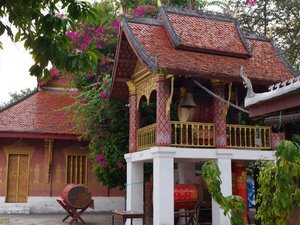
Everyday (except on the rainy day when we made the marmots), we visited temples: very often golden and red in colour, they are unmistakable and very photogenic. The woodwork inside the various religious buildings was well worked, each one revealing large golden Buddhas. At 6 p. m., the monks gathered in the prayer room and we could attend it.
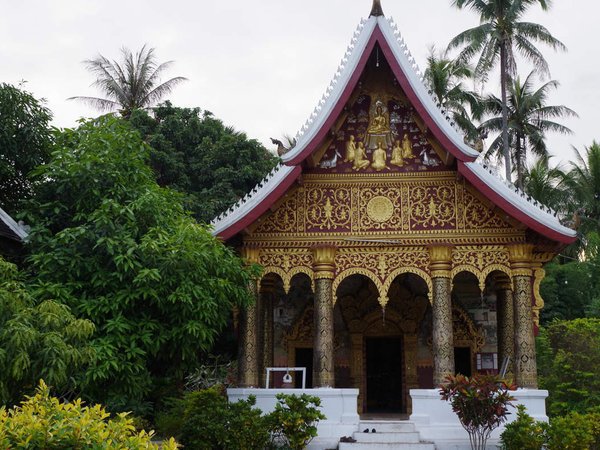
From our first day, we noticed a certain effervescence in the main street. Indeed, from 4 p. m., the street filled with souvenir stalls, clothes and stands preparing mixed fruits and baguette sandwiches (especially with avocado that we tested). It was the night market. Very difficult to resist in front of all these fabrics for some of them very beautiful. Skirts, dresses, dresses, stoles, cotton or silk coloured by indigo, baskets, bags... the local productions are very numerous here, and this is what made us want to visit a few days later a center of silk fabrics factory.
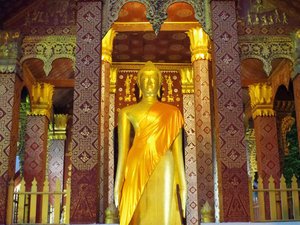
On the third day, we moved away from the old town and, after crossing a metal and wooden bridge with a beautiful view of the Nam Kan River, we wandered through a more popular neighborhood with much more modest architecture and narrow dirt alleys.
We tested the Lao fondue in a restaurant where it was the speciality: like in Vietnam, we put a lot of things in a broth but here, thin strips of meat are grilled on a central cone made of metal greased with pork rind, the juices of the meat flow into the broth and help to perfume it.
We then crossed the same river over a bamboo bridge (paying) that needs to be redone every year. We thus joined the old town and set off to attack Mount Phu Si.
We entered a rather modest temple and discovered by chance a staircase leading to Mount Phu Si. There was no one there because it wasn't the main access. After walking down several dragon-fringed stairs, entering a cave to observe a footprint of Buddha's foot and admiring several representations of Buddha's foot, we arrived at the very top where many pilgrims and tourists gathered to admire the panorama and pray in the temple. Among the offerings, a small bird in a cage could be bought to liberate it.
We descended down the stairs to the main street, offering a beautiful view of the temple of the royal palace. Finally, we took a gourmet break in a French bakery with tasty chocolate breads.
The next day, a bit far from the main arteries, we found the Centre for Traditional Arts and Ethnology, and by pure chance, we were just there for the weekly visit in French carried out by a Belgian academic. It was very interesting, especially the temporary exhibition on "Job's tears", very special cereal seeds (already naturally perforated) used for the decoration of minority clothing. In this small private museum, there are riddles for children, and at the end of the visit, ethnic clothing to dress up.
For our last day, we went to the famous waterfalls of Kuang Si in tuk-tuk, early in the morning, before the arrival of Chinese tourist buses. These waterfalls, in the middle of the forest, spreading over several levels are absolutely sublime. The turquoise water is an invitation to swim (we couldn't resist) but the water was very cool. We really found the place fantastic and at the height of the photos we had seen before.
At the entrance of the site, we passed through the Tat Kuang Si Bear Rescue Centre, this site collects collared bears suffering from poaching in Laos: a cannula is inserted at the gallbladder level and is left in place (it comes out outside the abdomen) to recover their bile. The bear then lives in a tiny cage (see photo) for years and years. Why so much ill-treatment? Because bear green bile is used in... traditional Chinese medicine (like rhino horns).
Congratulations @bridgescaroline! You have completed some achievement on Steemit and have been rewarded with new badge(s) :
Click on any badge to view your own Board of Honor on SteemitBoard.
For more information about SteemitBoard, click here
If you no longer want to receive notifications, reply to this comment with the word
STOP